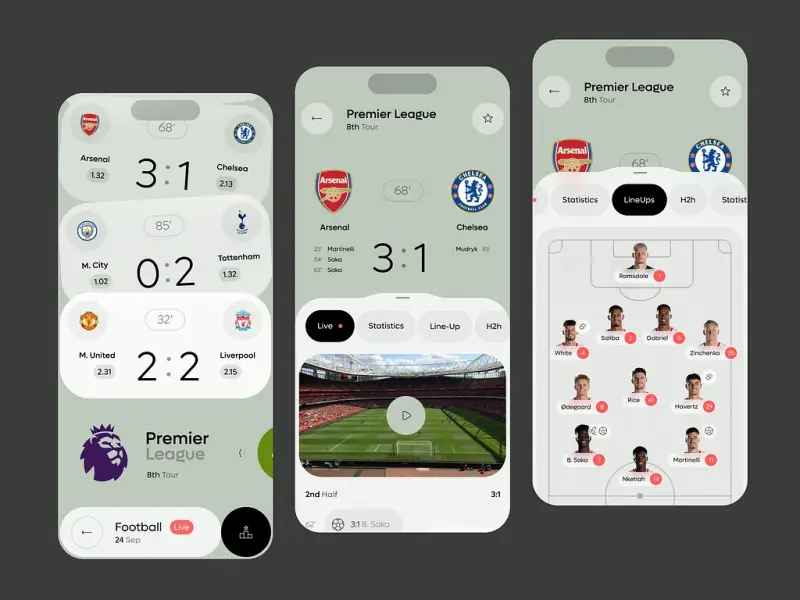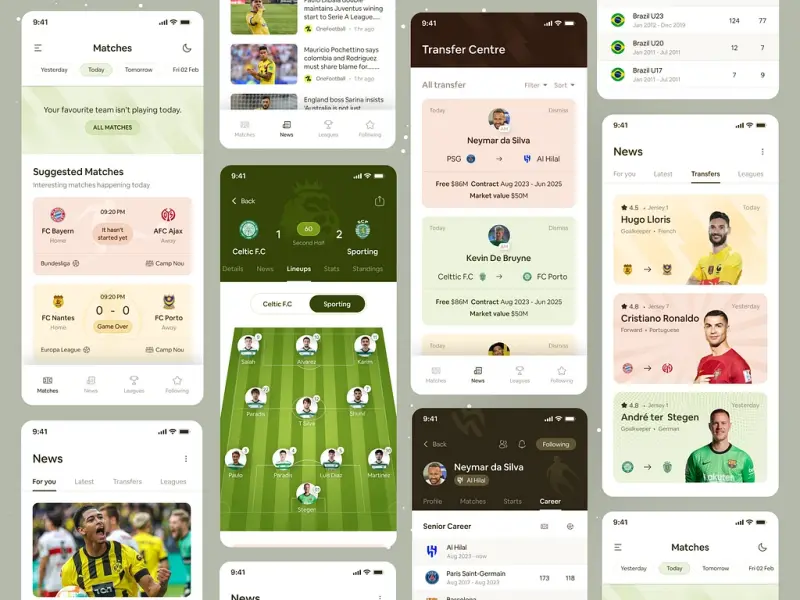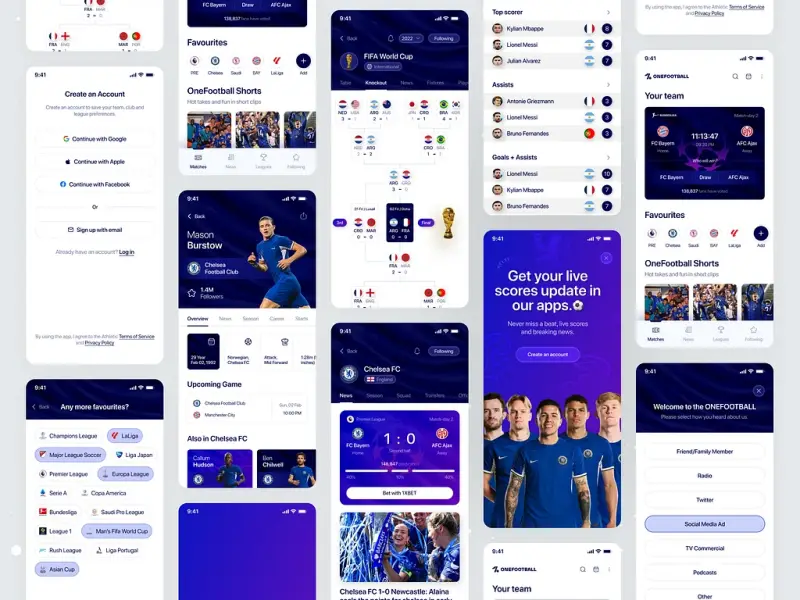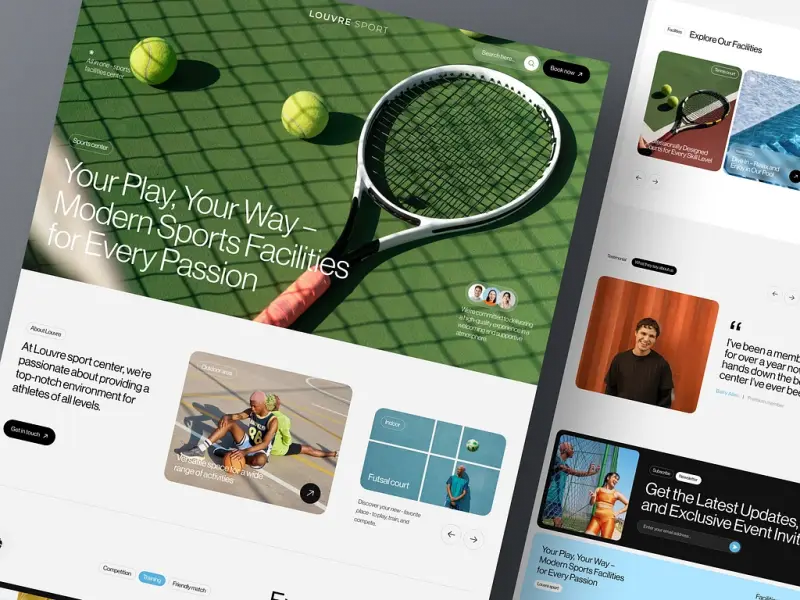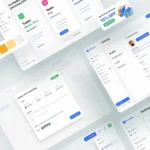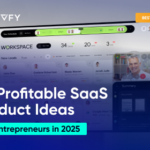How to Stay Ahead in Sports App Development: The Full Guide
- TECHVIFY Team
- January 13, 2025
- Knowledge, Guides
- 0 Comments
Sports apps have become a cornerstone of the entertainment app market, and it’s no surprise — the sports app industry alone is valued at a staggering $3.6 billion. Impressive, isn’t it? With the average sports fan spending nearly 50 minutes a day exclusively on sports apps, the market is brimming with potential.
But here’s the exciting part: you can join this success story too. From live streaming to fantasy leagues, the sports app development market offers endless opportunities for innovation, helping businesses connect with sports fans worldwide. Think about it — with countless sports, leagues, and events happening worldwide, there’s always room for a new app that caters to the needs of sports fans.
Whether you’re looking to create a platform for die-hard fans, coaches, or players, now is the perfect time to leverage sports application development to bring your mobile product to life. In this article, we’ll explore the main types of sports apps, the must-have features for each, and the steps needed to build an app that stands out in this lucrative market.
I. Get Inspired: Reviewing Popular Sports Apps for Design Ideas
The global sports technology market is booming, and the numbers speak for themselves. According to a Knowledge Sourcing Intelligence report, the market was valued at $17.188 billion in 2019 and is projected to grow to an astounding $58.946 billion by 2026, with a CAGR of 19.25% during the 2020-2026 period.
Sports application development
This rapid growth presents an incredible opportunity for app developers and designers to tap into a thriving industry. If you’re looking for inspiration for your own sports app, reviewing the design and features of popular sports apps is a great place to start. Let’s take a closer look at two standout examples that have successfully captured the attention of sports fans worldwide.
The Official NBA App
The official NBA app is a must-have for basketball fans, offering a comprehensive platform to stay connected with the game. Available on the web, Android, iOS, and other platforms, this app has established itself as a go-to source for all things NBA.
Here’s what makes it stand out:
- Live Streaming of Games: Watch games in real-time, no matter where you are.
- Live Scores: Stay updated with scores from ongoing matches.
- Official NBA Schedules: Never miss a game with readily available schedules.
- In-Game and Post-Game Highlights: Relive the best moments of every match.
- News and Events: Access select press conferences, team updates, and other exclusive content.
- Personalized Content: Tailored updates about your favorite NBA teams and players.
Design Takeaways:
- The app emphasizes clean navigation, ensuring users can quickly access key features like live games and scores.
- Dynamic visuals, such as game highlights and team logos, keep the interface engaging and visually appealing.
- Personalization features, like tailored team updates, enhance user experience and encourage regular use.
ESPN App
The ESPN app has set the gold standard for sports apps by catering to fans across multiple sports. Available on platforms like web, Android, iOS, Android TV, and Apple TV, this app delivers an all-in-one experience for sports enthusiasts.
Key features include:
- Live Streaming: Watch live games from a variety of popular sports.
- Live Scores: Get real-time updates on scores and match progress.
- News Alerts: Stay informed with breaking news and updates about your favorite teams and players.
- Highlights: Watch the best moments from games on-demand.
- Podcasts: Listen to expert commentary and analysis to stay ahead of the game.
Design Takeaways:
- The app uses a modular layout, making it easy for users to find specific content like live games, scores, or news.
- Push notifications keep users engaged by delivering instant updates on scores, breaking news, and upcoming games.
- The inclusion of multimedia content, such as podcasts and video highlights, adds variety and appeals to a broader audience.
Learn More On:
II. Main Types of Sports Apps to Consider
The sports app market is as diverse as the sports world itself. From helping teams stay organized to delivering an electrifying match-day experience, sports apps cater to a wide range of users. Let’s dive into the main types of sports apps and discover what makes them so valuable.
1. Team Management Apps
Managing a team — whether it’s a local amateur league or a professional sports club — can be challenging. This is where team management apps come in, offering a centralized hub for organizing practices, matches, and events. These apps are designed to make life easier for coaches, players, and managers alike.
Here’s what they offer:
- Scheduling Tools: Plan practices, games, and team events effortlessly.
- Attendance Tracking: Keep tabs on who’s available for the next big game.
- Training Plans: Coaches can create and distribute personalized training schedules for players.
- Budgeting and Travel Coordination: Some apps even go the extra mile, helping with team finances and travel logistics.
With team management apps, everything is under one roof, making it simple to keep track of a team’s activities and ensure everyone’s on the same page.
2. Fantasy Sports Apps
Fantasy sports apps are a fan favorite for a reason — they bring users closer to the action by letting them create their dream teams and compete in simulated leagues. These apps are a thrilling mix of strategy, statistics, and a little bit of gut instinct, making them both engaging and competitive.
Key features include:
- Draft and Manage Teams: Users can draft players, manage their rosters, and tweak strategies throughout the season.
- Performance Tracking: Earn points based on the real-life performance of selected athletes.
- Leagues and Tournaments: Compete with friends or join larger public tournaments for bragging rights (and sometimes prizes).
- Live Updates: Stay up-to-date with player stats and game results in real time.
Fantasy sports apps thrive on competition and community, making them a great way to engage sports fans and keep them coming back for more.
3. Sports Live Streaming Apps
Nothing beats the excitement of watching your favorite team play live. Sports live streaming apps make it possible for fans to catch the action anytime, anywhere — whether they’re commuting, running errands, or just away from a TV.
What these apps offer:
- High-Quality Streaming: Enjoy crystal-clear video and audio to experience the game as if you’re there in person.
- Live Commentary: Stay in the loop with expert commentary and real-time updates.
- Playback Options: Revisit missed moments with on-demand replays.
- Extra Engagement Features: Some apps offer multi-angle viewing or interactive live chats to enhance the experience.
Live streaming apps aren’t just limited to match broadcasts. They can also be used for training sessions, connecting sports trainers with students for online classes. It’s a flexible format that opens up new possibilities.
Sports app development services
4. Scoreboard Apps
For fans who can’t catch every match live, scoreboard apps are a lifesaver. These apps provide instant updates on scores, highlights, and live commentary, ensuring that users never miss a beat.
What makes them special:
- Real-Time Updates: Get live scores and match updates as the action unfolds.
- Detailed Player Stats: Dive deeper into player performance and game analytics.
- Personalized Notifications: Stay informed about your favorite teams, players, and leagues with customized alerts.
- Coverage of Niche Sports: Many scoreboard apps also cover less mainstream leagues and tournaments, catering to fans of niche sports.
Scoreboard apps are perfect for keeping fans informed, whether they’re following a major league or a local event.
5. Ticketing Apps
Gone are the days of endlessly browsing websites to find game tickets. Ticketing apps simplify this process by aggregating ticket options for various sports events in one place. These apps make it easy for fans to compare prices, check seat availability, and even explore different venues — all from the comfort of their phones.
Key features of ticketing apps include:
- Interactive Seating Maps: Allow users to visualize available seats before purchase.
- Personalized Recommendations: Tailor suggestions based on user preferences, favorite teams, or past purchases.
- Secure Payment Options: Ensure hassle-free and safe transactions.
- Add-Ons: Some apps go the extra mile, offering extras like parking passes, VIP lounge access, or pre-game experiences.
These apps not only simplify the ticket-buying process but also create a more personalized experience for fans, making them feel valued and engaged.
6. Sports Training Apps
Whether you’re an aspiring athlete or simply looking to stay fit, sports training apps have something for everyone. These apps cater to players of all levels, offering tools to improve skills, track progress, and stay motivated. Think of popular platforms like Nike Training Club or MyFitnessPal, which became lifesavers for fitness enthusiasts during the pandemic.
Advanced training apps typically include:
- Workout Plans: Tailored to specific sports, skill levels, or fitness goals.
- Performance Tracking: Monitor metrics like speed, endurance, or accuracy to measure progress.
- AI Chatbots: Provide personalized guidance and advice based on user performance.
- Video Tutorials: Offer demonstrations of techniques and drills for individual or team training.
For team sports, coaches can also upload custom training videos or drills to share with their players. With added tools like scheduling workouts or monitoring progress, these apps become invaluable for both individual athletes and organized teams.
Looking to Outsource Development?
Contact TECHVIFY, Vietnam’s Leading Offshore Software Development & Outsourcing Company, for a consultation and development services.
III. A Step-by-Step Guide to Developing a Sports App
Creating a successful app through sports app development services requires a combination of thoughtful planning, intuitive design, and seamless functionality to engage users. Here’s a step-by-step process to guide you through sports app development.
Step 1. Planning and Analysis
Every great app begins with a solid foundation. The planning phase is critical for defining the app’s purpose, target audience, and unique features. Here’s what it involves:
- Defining the Purpose: Is your app for live streaming, fantasy leagues, ticket booking, or real-time score updates? Identifying your app’s primary objective will shape the entire development process.
- Researching the Audience: Are you targeting fans of specific sports, local leagues, or international tournaments? Knowing your audience helps you tailor your features and design.
- Setting Objectives and Features: List the must-have and advanced features that will make your app stand out. For example, consider live streaming, AI-powered chatbots, or personalized content recommendations.
- Budgeting and Scheduling: Determine your budget and outline a timeline for development milestones. Share these details with your development team to align expectations.
- Choosing the Right Development Approach: Decide between native development (for high performance on iOS and Android) or cross-platform development (for cost efficiency and broader reach).
At TECHVIFY, we guide you through this process with expert consulting in sports app development services, helping you create innovative and user-centric sports apps. Our team offers competitor analysis, identifies untapped market opportunities, and helps shape your app idea into a winning strategy.
Step 2. Design and Prototyping
The design phase focuses on creating a visually appealing and user-friendly app. Sports apps thrive on engagement, so it’s crucial to design with your audience in mind.
Here’s how the design process unfolds:
- Wireframes: Develop initial layouts and navigation flows. For example, a ticketing app might include screens for event search, seat selection, and payment confirmation.
- User Journey Maps: Outline the steps users take to complete key tasks, such as purchasing tickets or setting up a fantasy team.
- UI Design: Once wireframes are approved, focus on visual elements like color schemes, typography, and branding. Sports apps often feature bold team colors, dynamic layouts, and sports-themed icons to create an immersive experience.
Great design ensures your app is intuitive to use and visually appealing, which is key to retaining users.
Step 3. Development and Testing
With the design ready, it’s time to bring your app to life. The development phase involves coding both the front-end (what users see) and the back-end (servers, databases, and APIs). Depending on your app’s functionality, you can choose between:
- Native Development: Ideal for performance-heavy apps like live streaming or gaming. iOS apps are built using Swift, while Android apps use Kotlin.
- Cross-Platform Development: Perfect for simpler apps like ticketing or scoreboards. Tools like Flutter allow developers to write one codebase for both platforms, saving time and money.
During development, integrating external services is crucial. For example:
- Sports Data APIs: Deliver real-time updates for live scores and player stats.
- Video Streaming Platforms: Ensure high-quality live streaming for matches or training sessions.
After coding, quality assurance (QA) testing ensures your app functions as intended. QA teams evaluate:
- Functionality: Are features like ticket booking or live streaming working seamlessly?
- Performance: Can the app handle heavy traffic during major events?
- Usability: Is navigation intuitive for users of all tech levels?
You can also conduct user testing with representatives of your target audience to gather feedback before launch.
Sports app development
Step 4. Deployment and Maintenance
Once your app passes testing, it’s ready for deployment. This involves publishing the app on platforms like the App Store and Google Play, ensuring it meets all technical requirements.
But the work doesn’t stop there — post-launch maintenance is vital to keeping your app relevant. This includes:
- Fixing Bugs: Addressing issues reported by users.
- Adding Features: Introducing enhancements like social sharing, AI chatbots, or new personalization options.
- Updating for New Platforms: Ensuring compatibility with the latest iOS and Android versions.
At TECHVIFY, we provide ongoing support to help your app grow. Whether it’s scaling features for major tournaments or adding interactive elements, we’re here to ensure your app stays ahead of the curve.
Learn More On:
IV. Top Emerging Trends in Sports App Development
The sports app market is expanding rapidly, driven by rising demand for innovative and engaging experiences. In 2023, the market was valued at USD 3.89 billion, and forecasts predict it will reach USD 8.03 billion by 2030. However, this growth comes with increased competition, pushing startups and businesses to adopt novel solutions that meet the needs of ever-demanding users.
To stay ahead in this competitive space, it’s crucial to understand the cutting-edge trends shaping sports app development services and how they can meet user demands. Here are the top 6 emerging trends that are transforming the industry and setting new standards for user engagement.
Augmented and Virtual Reality (AR/VR)
AR and VR are revolutionizing the way fans and athletes interact with sports. These technologies offer immersive experiences that were once unimaginable:
- For Fans: AR enhances live matches with interactive statistics, graphics, and visual commentary, creating a more engaging viewing experience. VR allows fans to enjoy 360-degree game views, making them feel like they’re right in the stadium, even from the comfort of their homes.
- For Athletes and Coaches: VR-powered simulations are redefining tactical training by analyzing match scenarios and helping players sharpen their skills. These tools also aid in injury prevention, offering athletes a safer and more effective way to train.
By integrating AR/VR, sports application development can elevate fan engagement and athlete performance to a whole new level, offering immersive and interactive experiences.
Artificial Intelligence (AI) for Performance Analysis
AI is transforming sports app development, revolutionizing sports training and performance monitoring with real-time insights and predictive analytics. With real-time tracking and predictive capabilities, it’s becoming a game-changer for athletes and app users alike:
- Real-Time Insights: AI tracks performance metrics with precision, identifying areas of improvement and helping athletes optimize their training routines.
- Injury Prevention: By analyzing patterns in performance data, AI can predict the likelihood of injuries and recommend preventive measures.
- Personalized Training Plans: AI tailors workouts and recovery plans based on individual needs, goals, and progress, offering a customized experience for every user.
Whether for elite athletes or fitness enthusiasts, AI ensures smarter, data-driven approaches to training and recovery.
Wearable Technology Integration
Wearable devices like smartwatches, fitness trackers, and smart clothing are becoming essential tools in sports application development, offering real-time health and performance data. These devices collect real-time health and performance data, offering users a deeper understanding of their physical activity:
- For Users: Track metrics like heart rate, stress levels, and calorie burn, enabling users to optimize workouts and adopt healthier lifestyles.
- For Coaches: Use wearable data to design personalized training programs that align with athletes’ unique abilities and limitations.
By integrating wearable tech, sports apps can enhance both individual and team performance, making data-driven fitness more accessible than ever.
Gamification and Social Features
Gamification is a proven way to boost user engagement, and sports apps are leveraging this trend with features that keep users motivated and invested:
- Leaderboards and Challenges: Users can compete with friends or other app users, making workouts more exciting.
- Rewards and Achievements: Gamified rewards incentivize users to reach milestones, fostering long-term engagement.
- Social Integration: Features like live chats, social media sharing, and activity feeds create a sense of community, encouraging users to stay active and connected.
Gamification and social features are becoming indispensable in sports app development, transforming apps into dynamic ecosystems that combine fitness, fun, and friendly competition.
Sports application development trends
Personalization and Customization
In today’s world, personalization is no longer optional — it’s expected. Sports apps are embracing this trend by using algorithms to deliver tailored experiences for every user:
- Customized Recommendations: Apps now suggest workouts, nutrition tips, and training schedules based on user preferences and data.
- Adaptive Features: Apps respond to user feedback and progress, adjusting plans to keep users motivated and engaged.
- Long-Term Engagement: Personalization fosters a deeper connection between users and the app, making it more likely they’ll stick to their fitness or training goals.
By putting the user at the center, apps can offer a more meaningful experience that drives loyalty and satisfaction.
Live Broadcasting and Streaming
Live broadcasting is no longer just an add-on — it’s a must-have feature for modern sports apps. Today’s platforms are combining live streaming with interactive features to provide a richer viewing experience:
- Real-Time Statistics: Keep fans engaged with in-game analytics, heatmaps, and player stats.
- Expert Commentary: Add depth to broadcasts with live commentary and expert insights.
- Social Interaction: Features like live chats during games allow fans to connect, creating a more interactive experience.
By merging live streaming with social and analytical tools, sports apps are redefining how fans watch and interact with their favorite games.
Conclusion
The world of sports app development is evolving rapidly, fueled by innovative technologies and the growing demands of fans, athletes, and coaches. Whether AR/VR for immersive game experiences, AI for personalized training, or gamified features that keep users engaged, the opportunities for creating impactful sports apps are endless.
If you’re ready to turn your vision into reality, TECHVIFY is here to help. With expertise in sports app development services, we offer tailored solutions to bring your app idea to life. From concept to deployment, we’ll guide you every step of the way, ensuring a seamless process and exceptional results. Contact TECHVIFY today for a free consultation and let’s create a sports app that stands out in the market and wins over users.
TECHVIFY – Global AI & Software Solution Company
From Startups to Industry Leaders: TECHVIFY prioritizes results, not just deliverables. Accelerate your time to market and see ROI early with high-performing teams, AI (including GenAI) Software Solutions, and ODC (Offshore Development Center) services.
- Email: [email protected]
- Phone: (+84)24.77762.666




